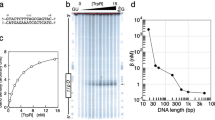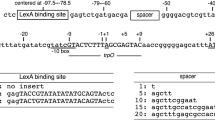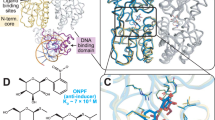Abstract
From the first high-resolution structure of a repressor bound specifically to its DNA recognition sequence1 it has been shown that the phage 434 repressor protein binds as a dimer to the helix. Tight, local interactions are made at the ends of the binding site, causing the central four base pairs (bp) to become bent and overtwisted. The centre of the operator is not in contact with protein but repressor binding affinity can be reduced at least 50-fold in response to a sequence change there2. This observation might be explained should the structure of the intervening DNA segment vary with its sequence, or if DNA at the centre of the operator resists the torsional and bending deformation necessary for complex formation in a sequence dependent fashion. We have considered the second hypothesis by demonstrating that DNA stiffness is sequence dependent. A method is formulated for calculating the stiffness of any particular DNA sequence, and we show that this predicted relationship between sequence and stiffness can explain the repressor binding data in a quantitative manner. We propose that the elastic properties of DNA may be of general importance to an understanding of protein–DNA binding specificity.
This is a preview of subscription content, access via your institution
Access options
Subscribe to this journal
Receive 51 print issues and online access
$199.00 per year
only $3.90 per issue
Buy this article
- Purchase on Springer Link
- Instant access to full article PDF
Prices may be subject to local taxes which are calculated during checkout
Similar content being viewed by others
References
Anderson, J. E., Ptashne, M. & Harrison, S. C. Nature 326, 846–852 (1987).
Koudelka, G. B., Harrison, S. B. & Ptashne, M. Nature 326, 886–888 (1987).
Peterlin, A. Nature 171, 259–262 (1953).
Landau, L. & Lifshitz, E. M. in Statistical Physics (Addison-Wesley, Reading, 1958).
Barkley, M. D. & Zimm, B. H. J. chem. Phys. 70, 2991–3007 (1979).
Millar, D. P., Robbins, R. J. & Zuwail, A. H. J. chem. Phys. 76, 2080–2094 (1982).
Hogan, M., LeGrange, J. & Austin, B. Nature 304, 752–754 (1983).
Thomas, T. J. & Bloomfield, V. A. Nucleic Acids Res. 11, 1919–1931 (1983).
Chen, H. H., Rau, D. C. & Charney, E. J. biomolec. struct. Dynam. 2, 709–719 (1985).
Berkoff, B., Hogan, M., LeGrange, J. & Austin, R. Biopolymers 25, 307–316 (1986).
Wu, H. M. & Crothers, D. M. Nature 308, 509–513 (1984).
Fujimoto, B. S., Shibata, J. H., Schurr, R. L. & Schurr, J. M. Biopolymers 24, 1009–1022 (1985).
Fratini, A. V., Kopka, M. L., Drew, H. R. & Dickerson, R. E. J. biol. Chem. 257, 14686–14707 (1982).
Ulanovsky, L., Bodner, M., Trifonov, E. N. & Choder, M. Proc. natn. Acad. Sci. U.S.A 83, 862–866 (1986).
Hagermann, P. Nature 321, 449–450 (1986).
Author information
Authors and Affiliations
Rights and permissions
About this article
Cite this article
Hogan, M., Austin, R. Importance of DNA stiffness in protein–DNA binding specificity. Nature 329, 263–266 (1987). https://doi.org/10.1038/329263a0
Received:
Accepted:
Issue Date:
DOI: https://doi.org/10.1038/329263a0
This article is cited by
-
Computationally identifying hot spots in protein-DNA binding interfaces using an ensemble approach
BMC Bioinformatics (2020)
-
Impact of Local Stiffness on Entropy Driven Microscopic Dynamics of Polythiophene
Scientific Reports (2020)
-
Evaluating the role of coherent delocalized phonon-like modes in DNA cyclization
Scientific Reports (2017)
-
Persistence Length and Cooperativity Estimation of Single Stranded DNA using FCS Combined with HYDRO Program
Journal of Fluorescence (2017)
-
Understanding the physics of DNA using nanoscale single-molecule manipulation
Frontiers of Physics (2012)
Comments
By submitting a comment you agree to abide by our Terms and Community Guidelines. If you find something abusive or that does not comply with our terms or guidelines please flag it as inappropriate.



